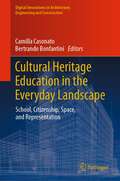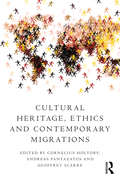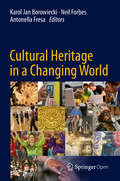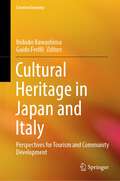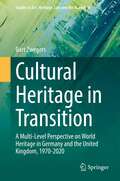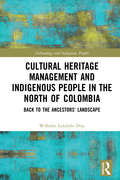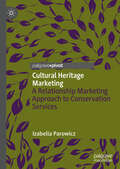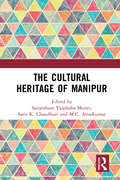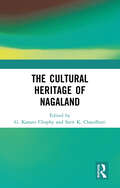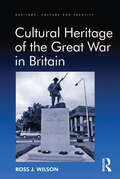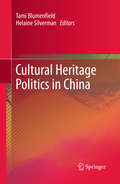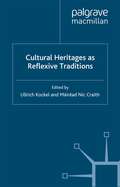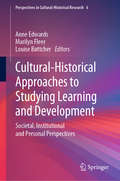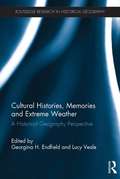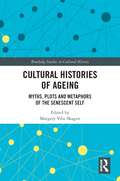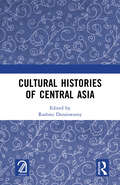- Table View
- List View
Cultural Heritage Education in the Everyday Landscape: School, Citizenship, Space, and Representation (Digital Innovations in Architecture, Engineering and Construction)
by Camilla Casonato Bertrando BonfantiniThis book summarizes work being undertaken within the School Activates Resources—stitching the lost heritage of the suburbs (ScAR) project, which addressed cultural heritage in a broad sense, as a system of values identified by the populations and in constant evolution. This tangible and intangible heritage fuels the promotion of intergenerational and intercultural dialogue and represents an opportunity for resilient social and territorial development. The book ponders the experience gained and the points of view of the different disciplines involved, examines issues such as children and youth participation in civil life or education in cultural heritage and landscape, and presents real-world experiences of heritage education in everyday landscape in difficult contexts and/or concerning poorly recognized and valued cultural heritage.
Cultural Heritage, Ethics and Contemporary Migrations
by Cornelius Holtorf Andreas Pantazatos Geoffrey ScarreCultural Heritage, Ethics and Contemporary Migrations breaks new ground in our understanding of the challenges faced by heritage practitioners and researchers in the contemporary world of mass migration, where people encounter new cultural heritage and relocate their own. It focuses particularly on issues affecting archaeological heritage sites and artefacts, which help determine and maintain social identity, a role problematised when populations are in flux. This diverse and authoritative collection brings together international specialists to discuss socio-political and ethical implications for the management of archaeological heritage in global society. With contributions by authors from a range of disciplinary backgrounds, including archaeologists, philosophers, cultural historians and custodians of cultural heritage, the volume explores a rich mix of contrasting, yet complementary, viewpoints and approaches. Among the topics discussed are the relations between culture and identity; the potentialities of museums and monuments to support or subvert a people’s sense of who they are; and how cultural heritage has been used to bring together communities containing people of different origins and traditions, yet without erasing or blurring their distinctive cultural features. Cultural Heritage, Ethics and Contemporary Migrations is a crucial text for archaeologists, curators, policymakers and others working in the heritage field, as well as for philosophers, political scientists and other readers interested in the links between immigration and cultural heritage.
Cultural Heritage, Ethics and Contemporary Migrations
by Cornelius Holtorf Andreas Pantazatos Geoffrey ScarreCultural Heritage, Ethics and Contemporary Migrations breaks new ground in our understanding of the challenges faced by heritage practitioners and researchers in the contemporary world of mass migration, where people encounter new cultural heritage and relocate their own. It focuses particularly on issues affecting archaeological heritage sites and artefacts, which help determine and maintain social identity, a role problematised when populations are in flux. This diverse and authoritative collection brings together international specialists to discuss socio-political and ethical implications for the management of archaeological heritage in global society. With contributions by authors from a range of disciplinary backgrounds, including archaeologists, philosophers, cultural historians and custodians of cultural heritage, the volume explores a rich mix of contrasting, yet complementary, viewpoints and approaches. Among the topics discussed are the relations between culture and identity; the potentialities of museums and monuments to support or subvert a people’s sense of who they are; and how cultural heritage has been used to bring together communities containing people of different origins and traditions, yet without erasing or blurring their distinctive cultural features. Cultural Heritage, Ethics and Contemporary Migrations is a crucial text for archaeologists, curators, policymakers and others working in the heritage field, as well as for philosophers, political scientists and other readers interested in the links between immigration and cultural heritage.
Cultural Heritage in a Changing World
by Karol Jan Borowiecki Neil Forbes Antonella FresaThe central purpose of this collection of essays is to make a creative addition to the debates surrounding the cultural heritage domain. In the 21st century the world faces epochal changes which affect every part of society, including the arenas in which cultural heritage is made, held, collected, curated, exhibited, or simply exists. The book is about these changes; about the decentring of culture and cultural heritage away from institutional structures towards the individual; about the questions which the advent of digital technologies is demanding that we ask and answer in relation to how we understand, collect and make available Europe’s cultural heritage. Cultural heritage has enormous potential in terms of its contribution to improving the quality of life for people, understanding the past, assisting territorial cohesion, driving economic growth, opening up employment opportunities and supporting wider developments such as improvements in education and in artistic careers. Given that spectrum of possible benefits to society, the range of studies that follow here are intended to be a resource and stimulus to help inform not just professionals in the sector but all those with an interest in cultural heritage.
Cultural Heritage in Japan and Italy: Perspectives for Tourism and Community Development (Creative Economy)
by Nobuko Kawashima Guido FerilliThis edited book represents one of the first scholarly research through an international collaboration project between Japan and Italy to address economic and social values of cultural heritage beyond its inherent—historic, archaeological, or aesthetic—values. Cultural policies in the world have over the decades expanded to include non-cultural purposes such as economic development and social inclusion. Japanese cultural policy for heritage is catching up on this trend: we have seen major shifts of emphasis from preservation for its sake to the utilisation of cultural heritage for the purposes of tourism, place branding, local vitalization and community-building, whilst Italy has long thrived on the economy of heritage tourism and more cases are being seen for urban and regional development with the use of cultural assets. The recent outbreak of Covid-19 and the problem of over-tourism that preceded it have challenged tourism policy and practice in the two countries.This book identifies emerging trends, issues, and problems in such policy shifts. The book breaks a new ground in the bourgeoning studies of tourism, heritage, and cultural policy by adopting an international, inter-disciplinary approach. The chapters on Japan in particular make an original contribution to these fields in the English literature in which discussion of Japan despite its economic and cultural presence on the globe has hitherto been less available.
Cultural Heritage in Transition: A Multi-Level Perspective on World Heritage in Germany and the United Kingdom, 1970-2020 (Studies in Art, Heritage, Law and the Market #4)
by Bart ZwegersThis book introduces the multilevel perspective to analyze how local, national, and international actors and institutions in the heritage field interact. More specifically, a comparative study is made of controversies regarding six UNESCO World Heritage sites in Germany and the United Kingdom. The six cases involve traditional monuments (the cathedral of Aachen and the castle and cathedral of Durham), industrial heritage (the Zollverein Coal Mine in Essen and the former tin and copper mines in Cornwall), and cities (Dresden and Liverpool). Studying how long-term landscape developments interact with local actors and nationally organized regimes reveals important differences between the decentralized German and the centralized British approach to heritage preservation. These differences not only have consequences for the governance of heritage preservation in the two countries, but also for their relations with international organizations such as UNESCO.
Cultural Heritage Management and Indigenous People in the North of Colombia: Back to the Ancestors' Landscape (Archaeology and Indigenous Peoples)
by Wilhelm Londoño DíazCultural Heritage Management and Indigenous People in the North of Colombia explores indigenous people's struggle for territorial autonomy in an aggressive political environment and the tensions between heritage tourism and Indigenous rights. South American cases where local communities, especially Indigenous groups, are opposed to infrastructure projects, are little known. This book lays out the results of more than a decade of research in which the resettlement of a pre-Columbian village has been documented. It highlights the difficulty of establishing the link between archaeological sites and objects, and Indigenous people due to legal restrictions. From a decolonial framework, the archaeology of Pueblito Chairama (Teykú) is explored, and the village stands as a model to understand the broader picture of the relationship between Indigenous people and political and economic forces in South America. The book will be of interest to researchers in Archaeology, Anthropology, Heritage and Indigenous Studies who wish to understand the particularities of South American repatriation cases and Indigenous archaeology in the region.
Cultural Heritage Management and Indigenous People in the North of Colombia: Back to the Ancestors' Landscape (Archaeology and Indigenous Peoples)
by Wilhelm Londoño DíazCultural Heritage Management and Indigenous People in the North of Colombia explores indigenous people's struggle for territorial autonomy in an aggressive political environment and the tensions between heritage tourism and Indigenous rights. South American cases where local communities, especially Indigenous groups, are opposed to infrastructure projects, are little known. This book lays out the results of more than a decade of research in which the resettlement of a pre-Columbian village has been documented. It highlights the difficulty of establishing the link between archaeological sites and objects, and Indigenous people due to legal restrictions. From a decolonial framework, the archaeology of Pueblito Chairama (Teykú) is explored, and the village stands as a model to understand the broader picture of the relationship between Indigenous people and political and economic forces in South America. The book will be of interest to researchers in Archaeology, Anthropology, Heritage and Indigenous Studies who wish to understand the particularities of South American repatriation cases and Indigenous archaeology in the region.
Cultural Heritage Marketing: A Relationship Marketing Approach to Conservation Services
by Izabella ParowiczProviding an overview of the marketing principles and tools that pertain to the area of heritage conservation services, this book combines research and practice to offer an alternative to the classical transactional marketing approach. Instead, the author argues for the relationship marketing approach, promoted and adopted by the Nordic School of Service Marketing. Offering a startlingly rare, but logical and practical marketing approach, this book also provides food for thought for academics dealing with managerial and marketing aspects in the field of cultural heritage and cultural heritage services.
The Cultural Heritage of Manipur
by S. Yaiphaba MeiteiThe Indira Gandhi Rashtriya Manav Sangrahalaya, Bhopal has a project to map the cultural heritage of North-East India. One volume is planned on each state. Manipur is one of the unique multi-ethnic states of North-East India which has a complex but distinctive cultural heritage of its own. This book presents the different facets of the cultural heritage of the border state of Manipur ingrained within its historicity, identity and political ecology. This book will be of much value for scholars across the disciplinary frames and pave the way for further research. Please note: Taylor & Francis does not sell or distribute the Hardback in India, Pakistan, Nepal, Bhutan, Bangladesh and Sri Lanka.
The Cultural Heritage of Manipur
by Sanjenbam Yaiphaba Meitei Sarit K. Chaudhuri M. C. ArunkumarThe Indira Gandhi Rashtriya Manav Sangrahalaya, Bhopal has a project to map the cultural heritage of North-East India. One volume is planned on each state. Manipur is one of the unique multi-ethnic states of North-East India which has a complex but distinctive cultural heritage of its own. This book presents the different facets of the cultural heritage of the border state of Manipur ingrained within its historicity, identity and political ecology. This book will be of much value for scholars across the disciplinary frames and pave the way for further research. Please note: Taylor & Francis does not sell or distribute the Hardback in India, Pakistan, Nepal, Bhutan, Bangladesh and Sri Lanka.
The Cultural Heritage of Nagaland
by G. Kanato Chophy Sarit K. ChaudhuriThis volume gives an in-depth account of cultural heritage of Nagaland covering important themes like cultural beliefs, traditional knowledge, material culture, and social institutions. Contributors from diverse disciplines and backgrounds have delved into the cultural heritage of the state’s variegated tribes. Nagaland a hilly state in North-East India had been the centre of British colonialism and American Baptist mission. This cultural contact is significantly reflected in the socio-cultural life, and the contributors have shed light on the continuities and changes. This volume highlights the multiplicity of cultural traditions that are specific to various tribes inhabiting sixteen districts of Nagaland, since their experiences of modernity and cultural contact with ‘others’ have been diverse. The contributors have mainly focussed on the cultural heritage of the majority Naga tribes, but other tribes like the Kukis and Kacharis are part and parcel of the cultural melting pot of Nagaland, and this volume in a way underscores the cultural exchange and interactions. Taylor & Francis does not sell or distribute the print version of this book in India, Pakistan, Nepal, Bhutan, Bangladesh and Sri Lanka.
The Cultural Heritage of Nagaland
by G. Kanato Chophy Sarit K. ChaudhuriThis volume gives an in-depth account of cultural heritage of Nagaland covering important themes like cultural beliefs, traditional knowledge, material culture, and social institutions. Contributors from diverse disciplines and backgrounds have delved into the cultural heritage of the state’s variegated tribes. Nagaland a hilly state in North-East India had been the centre of British colonialism and American Baptist mission. This cultural contact is significantly reflected in the socio-cultural life, and the contributors have shed light on the continuities and changes. This volume highlights the multiplicity of cultural traditions that are specific to various tribes inhabiting sixteen districts of Nagaland, since their experiences of modernity and cultural contact with ‘others’ have been diverse. The contributors have mainly focussed on the cultural heritage of the majority Naga tribes, but other tribes like the Kukis and Kacharis are part and parcel of the cultural melting pot of Nagaland, and this volume in a way underscores the cultural exchange and interactions. Taylor & Francis does not sell or distribute the print version of this book in India, Pakistan, Nepal, Bhutan, Bangladesh and Sri Lanka.
Cultural Heritage of the Great War in Britain (Heritage, Culture and Identity)
by Ross J. WilsonAs the hundredth anniversary approaches, it is timely to reflect not only upon the Great War itself and on the memorials which were erected to ensure it did not slip from national consciousness, but also to reflect upon its rich and substantial cultural legacy. This book examines the heritage of the Great War in contemporary Britain. It addresses how the war maintains a place and value within British society through the usage of phrases, references, metaphors and imagery within popular, media, heritage and political discourse. Whilst the representation of the war within historiography, literature, art, television and film has been examined by scholars seeking to understand the origins of the 'popular memory' of the conflict, these analyses have neglected how and why wider popular debate draws upon a war fought nearly a century ago to express ideas about identity, place and politics. By examining the history, usage and meanings of references to the Great War within local and national newspapers, historical societies, political publications and manifestos, the heritage sector, popular expressions, blogs and internet chat rooms, an analysis of the discourses which structure the remembrance of the war can be created. The book acknowledges the diversity within Britain as different regional and national identities draw upon the war as a means of expression. Whilst utilising the substantial field of heritage studies, this book puts forward a new methodology for assessing cultural heritage and creates an original perspective on the place of the Great War across contemporary British society.
Cultural Heritage of the Great War in Britain (Heritage, Culture and Identity)
by Ross J. WilsonAs the hundredth anniversary approaches, it is timely to reflect not only upon the Great War itself and on the memorials which were erected to ensure it did not slip from national consciousness, but also to reflect upon its rich and substantial cultural legacy. This book examines the heritage of the Great War in contemporary Britain. It addresses how the war maintains a place and value within British society through the usage of phrases, references, metaphors and imagery within popular, media, heritage and political discourse. Whilst the representation of the war within historiography, literature, art, television and film has been examined by scholars seeking to understand the origins of the 'popular memory' of the conflict, these analyses have neglected how and why wider popular debate draws upon a war fought nearly a century ago to express ideas about identity, place and politics. By examining the history, usage and meanings of references to the Great War within local and national newspapers, historical societies, political publications and manifestos, the heritage sector, popular expressions, blogs and internet chat rooms, an analysis of the discourses which structure the remembrance of the war can be created. The book acknowledges the diversity within Britain as different regional and national identities draw upon the war as a means of expression. Whilst utilising the substantial field of heritage studies, this book puts forward a new methodology for assessing cultural heritage and creates an original perspective on the place of the Great War across contemporary British society.
Cultural Heritage Politics in China
by Tami Blumenfield and Helaine SilvermanThis volume explores China’s cultural heritage ideology and policies from three interrelated perspectives: the State and World Heritage tourism; cultural heritage tourism at undesignated sites, and the cultural politics of museums and collections. Something of a cultural heritage designation craze is happening in China. This is new within even the last five to ten years. Officials at many levels now see heritage preservation as a means for commoditizing their regions. They are devoting new resources and attention to national and international heritage designations. Thus, addressing cultural heritage politics in a nation dedicated to designation is an important project, particularly in the context of a rapidly growing economy. This volume is also important because it addresses a very wide range of cultural heritage, providing an excellent sample of case studies: historic vernacular urban environments, ethnic tourism, scenic tourism, pilgrimage as tourism, tourism and economic development, museums, border heritage, underwater remains, and the actual governance and management of the sites. This volume is an outstanding introduction to cultural heritage issues in China while contributing to Chinese studies for those with greater knowledge of the area.
Cultural Heritages as Reflexive Traditions
by U. Kockel M. Nic Craith Máiréad Nic CraithDrawing on anthropological fieldwork, this book presents case studies illustrating the re-conceptualization of heritages and traditions in selected locations in Africa, Asia, Australia and Europe. The authors review the importance of oral traditions as markers of identity and consider competing narratives of heritage in postcolonial societies.
Cultural-Historical Approaches to Studying Learning and Development: Societal, Institutional and Personal Perspectives (Perspectives in Cultural-Historical Research #6)
by Anne Edwards Marilyn Fleer Louise BøttcherThis collection of papers examines key ideas in cultural-historical approaches to children’s learning and development and the cultural and institutional conditions in which they occur. The collection is given coherence by a focus on the intellectual contributions made by Professor Mariane Hedegaard to understandings of children’s learning through the prism of the interplay of society, institution and person. She has significantly shaped the field through her scholarly consideration of foundational concepts and her creative attention to the fields of activity she studies. The book brings together examples of how these concepts have been employed and developed in a study of learning and development. The collection allows the contributing scholars to reveal their reactions to Hedegaard’s contributions in discussions of their own work in the field of children’s learning and the conditions in which it occurs.
Cultural Histories, Memories and Extreme Weather: A Historical Geography Perspective (Routledge Research in Historical Geography)
by Georgina H. Endfield Lucy VealeExtreme weather events, such as droughts, strong winds and storms, flash floods and extreme heat and cold, are among the most destructive yet fascinating aspects of climate variability. Historical records and memories charting the impacts and responses to such events are a crucial component of any research that seeks to understand the nature of events that might take place in the future. Yet all such events need to be situated for their implications to be understood. This book is the first to explore the cultural contingency of extreme and unusual weather events and the ways in which they are recalled, recorded or forgotten. It illustrates how geographical context, particular physical conditions, an area’s social and economic activities and embedded cultural knowledges and infrastructures all affect community experiences of and responses to unusual weather. Contributions refer to varied methods of remembering and recording weather and how these act to curate, recycle and transmit extreme events across generations and into the future. With international case studies, from both land and sea, the book explores how and why particular weather events become inscribed into the fabric of communities and contribute to community change in different historical and cultural contexts. This is valuable reading for students and researchers interested in historical and cultural geography, environmental anthropology and environmental studies.
Cultural Histories, Memories and Extreme Weather: A Historical Geography Perspective (Routledge Research in Historical Geography)
by Georgina H. Endfield Lucy VealeExtreme weather events, such as droughts, strong winds and storms, flash floods and extreme heat and cold, are among the most destructive yet fascinating aspects of climate variability. Historical records and memories charting the impacts and responses to such events are a crucial component of any research that seeks to understand the nature of events that might take place in the future. Yet all such events need to be situated for their implications to be understood. This book is the first to explore the cultural contingency of extreme and unusual weather events and the ways in which they are recalled, recorded or forgotten. It illustrates how geographical context, particular physical conditions, an area’s social and economic activities and embedded cultural knowledges and infrastructures all affect community experiences of and responses to unusual weather. Contributions refer to varied methods of remembering and recording weather and how these act to curate, recycle and transmit extreme events across generations and into the future. With international case studies, from both land and sea, the book explores how and why particular weather events become inscribed into the fabric of communities and contribute to community change in different historical and cultural contexts. This is valuable reading for students and researchers interested in historical and cultural geography, environmental anthropology and environmental studies.
Cultural Histories of Ageing: Myths, Plots and Metaphors of the Senescent Self (Routledge Studies in Cultural History #102)
by Margery Vibe SkagenDrawing on sixteenth- to twenty-first-century American, British, French, German, Polish, Norwegian and Russian literature and philosophy, this collection teases out culturally specific conceptions of old age as well as subjective constructions of late-life identity and selfhood. The internationally known humanistic gerontologist Jan Baars, the prominent historian of old age David Troyansky and the distinguished cultural historian and pioneer in the field of literature and science George Rousseau join a team of literary historians who trace out the interfaces between their chosen texts and the respective periods’ medical and gerontological knowledge. The chapters’ in-depth analyses of major and less-known works demonstrate the rich potential of fiction, poetry and autobiographical writing in the construction of a cultural history of senescence. These literary examples not only bear witness to longue durée representations of old age, and epochal transitions regarding cultural attitudes to the aged; they also foreground the subjectivities that produced some of these representations and that continue to communicate with readers of other times and places. By casting a net over a variety of authors, genres, periods and languages, the collection gives a broad sense of how literature is among the richest and most engaging sources for historicizing the ageing self.
Cultural Histories of Ageing: Myths, Plots and Metaphors of the Senescent Self (Routledge Studies in Cultural History #102)
by Margery Vibe SkagenDrawing on sixteenth- to twenty-first-century American, British, French, German, Polish, Norwegian and Russian literature and philosophy, this collection teases out culturally specific conceptions of old age as well as subjective constructions of late-life identity and selfhood. The internationally known humanistic gerontologist Jan Baars, the prominent historian of old age David Troyansky and the distinguished cultural historian and pioneer in the field of literature and science George Rousseau join a team of literary historians who trace out the interfaces between their chosen texts and the respective periods’ medical and gerontological knowledge. The chapters’ in-depth analyses of major and less-known works demonstrate the rich potential of fiction, poetry and autobiographical writing in the construction of a cultural history of senescence. These literary examples not only bear witness to longue durée representations of old age, and epochal transitions regarding cultural attitudes to the aged; they also foreground the subjectivities that produced some of these representations and that continue to communicate with readers of other times and places. By casting a net over a variety of authors, genres, periods and languages, the collection gives a broad sense of how literature is among the richest and most engaging sources for historicizing the ageing self.
Cultural Histories of Central Asia
by Rashmi DoraiswamyCentral Asia, the 'heart' of the Eurasian landmass, has through the centuries been the hub of diverse and varied cultures. These cultures have encompassed pre-Islamic religions and Islam, sedentary and nomadic lifestyles and lived through rapid transitions from feudal, capitalist and socialist economies, from Tsarist to Soviet and post-Soviet formations. The essays in this volume examine the cultural exchanges and encounters that have occurred in the region through a vast timeline that extends from the premedieval to the medieval and modern periods. The writers are academics, as well as art practitioners and independent researchers who belong to a wide spectrum of disciplines: Central Asian and Russian Studies, Architecture, Ethno-Musicology, History, Painting, Film Studies, Art History, Textiles, Literature and International Relations. The volume presents a colourful mosaic of views on the many cultural histories of Central Asia.
Cultural Histories of Central Asia
by Rashmi DoraiswamyCentral Asia, the 'heart' of the Eurasian landmass, has through the centuries been the hub of diverse and varied cultures. These cultures have encompassed pre-Islamic religions and Islam, sedentary and nomadic lifestyles and lived through rapid transitions from feudal, capitalist and socialist economies, from Tsarist to Soviet and post-Soviet formations. The essays in this volume examine the cultural exchanges and encounters that have occurred in the region through a vast timeline that extends from the premedieval to the medieval and modern periods. The writers are academics, as well as art practitioners and independent researchers who belong to a wide spectrum of disciplines: Central Asian and Russian Studies, Architecture, Ethno-Musicology, History, Painting, Film Studies, Art History, Textiles, Literature and International Relations. The volume presents a colourful mosaic of views on the many cultural histories of Central Asia.
Cultural Histories of Crime in Denmark, 1500 to 2000 (Routledge Studies in Cultural History #55)
by Louise Nyholm Kallestrup Tyge Krogh Claus Bundgård ChristensenTaking the kingdom of Denmark as its frame of reference, this volume presents a range of close analyses that shed light on the construction and deconstruction of crime and criminals, on criminal cultures and on crime control from 1500 to 2000. Historically, there have been major changes in the legal definition of those acts that are legally defined as being criminal offences – and of those that are not. This volume explores the criteria and perceptions underlying definitions of crime in a powerful and absolutist Lutheran state and subsequently in a Denmark characterised by social welfare and sexual liberation. It places special focus on moral issues rooted in considerations of religion and sexuality.
